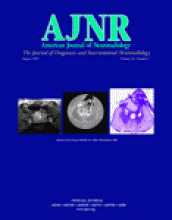Peraud et al (1) reported a fatal injection of Ethibloc into an aneurysmatic bone cyst of C2 due to inadvertent embolization in the vertebrobasilar system. The embolization material was found in a small branch artery of the vertebral artery at the C2 level. The authors suspect that the embolizing material passed into a side branch of the vertebral artery running into the aneurysmatic bone cyst. Our own experience with intravertebral contrast injection supports this theory. Within the vertebroplasty of osteolytic lesions of C2, we routinely perform vertebral phlebography. The contrast is injected via the needle placed to inject the bone cement. The background for this routine is the experience that osseous pathology in vertical vertebral bodies often is supplied by arterial branches of the vertebral arteries. In one patient with an osteolytic lesion from breast cancer, we could prove a retrograde filling of the left vertebral artery and subsequently the basilar artery by injection of contrast into the osteolytic lesion of the second vertebra. We found an impressive amount of contrast filling the posterior circulation (Fig 1). Direct arterial puncture could be excluded by needle position.
Consequently, we did perform vertebroplasty under biplanar fluoroscopy by using a higher viscosity of the bone cement than normally used. The patient was treated successfully and without any complication.
Anatomically, the vertebral arteries supply the bone in the cervical spine. Under normal conditions, the selective angiography of the vertebral arteries cannot visualize the vertebral supply, but highly perfused bone tumors (eg, metastases) in the cervical spine show tumor blush via selective vertebral injection. We do think that enlargement of anatomically normal arterial vessels supplying the vertebral bone due to pathologic structures in the bone are the basis for functional relevant connections between the osseous structures of the cervical spine and the posterior arterial circulation. We suggest performing contrast injection before embolization or cement injection into cervical vertebral bodies, regardless of individual pathology. Furthermore, biplanar fluorscopic control may help to avoid inadvertent embolization of the basilar artery.
Anteroposterior (A) and lateral (B) views of contrast injection into C2. The arrows mark the needle and instruments of the surgical access, which normally is used at our institution to perform vertebroplasty of C2. There is an early filling of the left vertebral artery and the basilar artery via small arterial branches.
References
- Copyright © American Society of Neuroradiology













